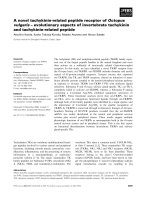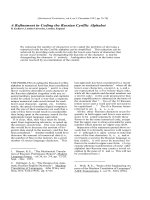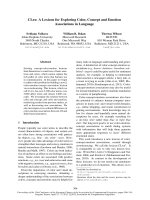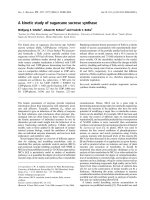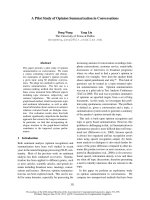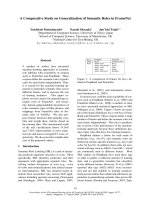báo cáo khoa học: " A pragmatic study exploring the prevention of delirium among hospitalized older hip fracture patients: Applying evidence to routine clinical practice using clinical decision support" potx
Bạn đang xem bản rút gọn của tài liệu. Xem và tải ngay bản đầy đủ của tài liệu tại đây (1.25 MB, 6 trang )
SHORT REPOR T Open Access
A pragmatic study exploring the prevention of
delirium among hospitalized older hip fracture
patients: Applying evidence to routine clinical
practice using clinical decision support
Jayna M Holroyd-Leduc
1*
, Greg A Abelseth
1
, Farah Khandwala
1
, James L Silvius
1
, David B Hogan
1
,
Heidi N Schmaltz
1
, Cyril B Frank
1
, Sharon E Straus
2
Abstract
Delirium occurs in up to 65% of older hip fracture patients. Developing delirium in hospital has been associate d
with a variety of adverse outcomes. Trials have shown that multi-component preventive interventions can lower
delirium rates. The objective of this study was to implement and evaluate the effectiveness of an evidence-based
electronic care pathway, which incorporates multi-component delirium strategies, among older hip fracture
patients. We conducted a pragmatic study using an interrupted time series design in order to evaluate the use and
impact of the intervention. The target population was all consenting patients aged 65 years or older admitted with
an acute hip fracture to the orthopedic units at two Calgary, Alberta hospitals. The primary outcome was delirium
rates. Secondary outcomes included length of hospital stay, in-hospital falls, in-hospital mortality, new discharges to
long-term care, and readmissions. A Durbin Watson test was conducted to test for serial correlation and, because
no correlation was found, Chi-square statistics, Wilcoxon test and logistic regression analyses wer e conducted as
appropriate. At study completion, focus groups were conducted at each hospital to explore issues around the use
of the order set. During the 40-week study period, 134 patients were enrolled. The intervention had no effect on
the overall delirium rate (33% pre versus 31% post; p = 0.84). However, there was a significant interaction between
study phase and hospital (p = 0.03). Although one hospital did not experience a decline in delirium rate, the delir-
ium rate at the other hospital declined from 42% to 19% (p = 0.08). This difference by hospital was mirrored in
focus group feedback. The hospital that experienced a decline in delirium rates was more supportive of the inter-
vention. Overall, post-intervention there were no significant differences in mean length of stay (12 days post versus
14 days pre; p = 0.74), falls (6% post versus 10% pre; p = 0.43) or discharges to long-term care (6% post versus
13% pre; p = 0.20). Translation of evidence-based multi-component delirium prevention strategies into everyday
clinical care, using the electronic medical record, was not found to be effective at decreasing delirium rates among
hip facture patients.
Background
Delirium, or acute confusion, occurs in 25 to 65% of
hospitalized patients treated for acute hip fracture
[1,2]. Local data showed that orthopedic inpatients
experienced the highest rates of delirium within the
surgical subspecialties. Delirium is defined as an acute
disturbance of con sciousness accompanied by a change
in cognition or by development of a perceptual distur-
bance [3]. Delirium develops over a short period of
time, tends to fluctuate over time and is usually due to
a general medical condition, substance intoxication,
and/or substance withdrawal [3]. Hip fracture patients
who develop delirium while in hospital have signifi-
cantly worse outcomes than those who do not become
delirious. Developing delirium in hospital has been
associated with death, longer length of hospital stay,
* Correspondence:
1
Foothills Medical Center, 1403-29
th
Street NW, Calgary, University of Calgary,
Calgary, Alberta, Canada
Full list of author information is available at the end of the article
Holroyd-Leduc et al. Implementation Science 2010, 5:81
/>Implementation
Science
© 2010 Holroyd-Leduc et al; licensee BioMed Central Ltd. This is an Open Access article distributed under the terms of the Creative
Commons Attribution License ( icenses/by/2.0), which permits unrestricted use, distribution, and
reproduction in any medium, provided the original work is properly cited.
increased hospital-acquired complications, persistent
cognitive deficits, and increased discharge rates to
long-term care [4-7]. Delirium is also predictive
of poor functional recovery among hip fracture
patients [5,8].
There are a number of preoperative factors that
increase the risk o f developing delirium after surgery,
including age, cognitive and functional impairment,
alcohol abuse, depression, abnormal preoperative elec-
trolytes, depression, co-morb id disease, sensory impair-
ment, and residing in a care facility [9,10]. Several
hospital -related precipitating factors also exist, including
physical restraints, malnutrition and dehydration, urin-
ary catheters, three or more new medications, and any
iatrogenic event [11]. The cause of delirium is rarely
due to just one factor; instead, multiple precipitating
factors typically contribute to its development [11].
Prevention is a key strategy when addressing delirium,
as after it occurs it can have devastating consequences
[4-8]. Interventions do not clear ly affect the duration of
delirium once it develops [12]. Given that multiple fac-
tors usually contribute to the development of delirium,
randomized trials have shown multi-component preven-
tative strategies to be most effective [12-15]. However,
given resource restraints, these multi-component strate-
gies are not always easy to translate and implement into
routine clinical care [16].
The evidence base around a ppropr iate dissemination
and implementation strategies is imperfect [17]. Compu-
terized clinical decision support systems, which are
information systems designed to improve clinical deci-
sion-making at the point of care, are one form of knowl-
edge translation found to be effective [18-20]. The
objective of this study was to determine if incorporation
of an evidence-based multi-component delirium preven-
tion strategy into an electronic post-operative hip frac-
ture clinical pathway, which i s a form of clinical
decision support, would result in a decrease in delirium
rates and related outcomes among older hip fracture
patients.
Methods
A pragmatic prospective cohort study using an inter-
rupted time series design was conducted among patients
admitted with a hip fracture to either of two Calgary,
Alberta teaching hospitals [21]. All patients aged 65
years or older who were admitted for surgical repair of
a hip fracture were eligible. Exclusion criteria included
an inability to speak English, fractures caused by a
motor vehicle crashes (given the mechanism of injury),
or inability to consent to the study. Patients were moni-
tored on the orthopedic wards for five months prior to
implementation (October 2008 to March 2009) of the
care pathway and then for five months post-implemen-
tation (March 2009 to August 2009).
The care pathway was developed wit h input from
information technologists, dec ision makers, researchers
and frontline healthcare providers from orthopedics,
geriatrics, and nursing. The delirium prevention strate-
gies within the care pathway were based on evidence
obtained from multi-component delirium prevention
trials conducted in acute care settings [12-15]. The care
pathway was developed to require minimal instruction
for use in order to maximize adherenc e and sustainabil-
ity within the dynamic work environment of a hospital
orthopedic ward. The developed care pathway was
embedded into the existing post-operative hip fracture
order set located on the hospitals’ electronic medical
record (Figure 1).
The care pathway also incorporates the Confusion
Assessment Method (CAM) [22], which is a brief delir-
ium diagnostic tool that is accurate (sensitivity 86%, spe-
cificity 93%), with high interobserver reliability [23].
Prior to the study, the CAM was introduced on the
orthopedic wards in order to aide in recognition o f
delirium. It was incorporated into the electronic post-
operative hip fracture order set.
The primary study outcome was change in delirium
rates as determined using a validated chart-based method
for identification of delirium [24]. Secondary outcomes
included length of hospital stay, in-hospital mortality,
documented falls in hospital, new discharges to lon g-
term care, and hospital readmission rates within 30 days.
Data collection techniques were standardized and kept
consistent throughout the study using an o perations
manual. One of two t rained chart abstractors reviewed
the hospital chart of each enrolled hip fracture patient
admitted during any one of 40 separate weekly assess-
ment time periods (20 pre- and 20 post-implementation).
Based on annual local hip fracture admission rates of
approximately 400 across the two hospitals, five months
post-intervention surv eillance (40 data points overall)
was felt to be sufficient to detect uptake into practice
[25]. Outcome data were collected from the hospital
chart of enrolled patients up until their discharge from
hospital or to the e nd of the 10-month study period.
Readmissions to hospital were tracked for one month
post- dischar ge. Patients were eligible for enrollment only
once. A Durbin Watson test was conducted to test for
serial correlation between weekly delirium rates and,
because no correlation was found, Chi-Square and
Wilcoxon tests were used to make u nivariab le compari-
sons, while logi stic regression analyses was used to com-
pare the effect of phase on delirium rates, while adju sting
for hospital. No other change to practice was known to
have occurred during the study.
Holroyd-Leduc et al. Implementation Science 2010, 5:81
/>Page 2 of 6
At study complet ion, focus groups (one at each hospi-
tal) were conducted with the frontline orthopedic nur-
sing staff in order to explore issues around the
implementation of the pathway. Nurses were recruited
through postings and using snowball sampling. Partici-
pation was considered to be implied consent. Focus
group participants were asked about facilitators and bar-
riers to using the pathway, ease of use, and for specific
feedback on its components. The focus groups were
conducted, prior to analyzing the quantitative outcomes,
by the principal investigator guided by a standardized
list of questions. A research assistant took notes, which
were later merged with data transcrib ed from audio
recordings. The transcripts were coded by the investiga-
tor using a content analysis approach. Themes were
identified and categorized. Only two focus groups were
conducted due to limitations around the availability of
frontline nurses to particip ate. This study received ethi-
cal approval from the University of Calgary Conjoint
Health Research Ethics Board.
Results
During the 40-week study period, 343 patients were
potentially eligible for enrolment (173 pre- and 170
Figure 1 Post-operative hip fracture order set with delirium prevention strategies.
Holroyd-Leduc et al. Implementation Science 2010, 5:81
/>Page 3 of 6
post-intervention). Among these patients 134 consented
to participate, 21 declined participation, 138 were incap-
able of consenting, and 50 were determined to be other-
wise ineligible. Among those enrolled, 102 were residing
in their own home prior to their hip fracture.
The intervention had no effect on the overall delirium
rate (Table 1). However, there was a significant inter ac-
tion between study phase and hospital (p = 0.033).
Although one hospital (hospital two) did not experience
a decline in their delirium rate, the delirium rate at the
other hospital (hospital one) declined from 42% to 19%
with the intervention (p = 0.076; Figure 2). There were
no significant changes in hospital length of stay, falls, or
discharges to long-term care facilities (Table 1). There
was one death among those enrolled, and six patients
were readmitted to hospital (two pre- and four post-
implementation; p = 0.340).
When focus grou p particip ants were asked about bar-
riers to using the pathway, both groups felt that there
was too much information to read and that orders could
be missed. Although both focus groups felt the delirium
strategies were based on ‘common sense,’ one group felt
the orders were insulting and the overwhelming consen-
sus amongst this group was that the pa thway was ‘pain-
ful’ to use. The other focus group felt the delirium
strategies were useful reminders of good practice, and
all these participants felt the pathway was easy to use.
Participants in this second group also commented that
the pathway (and doing the CAM) helped them to iden-
tify delirium and initiate management strategies earlier.
This second group was from the hospital that experi-
enced a 50% reduction in delirium rates.
Discussion
Our attempt to systematically incorporate evidence-
based multi-component delirium prevention strategies
[12-15] into p ractice resulted in mixed success.
Although we made efforts to obtain input from all levels
of the health care team during dev elopment, this project
highlights the importance of continuing to engage front-
line personnel because of issues like staff turnover and
the development of unexp ected barriers [26]. The focus
groups highlighted the potential impact of organiza-
tional culture, personnel changes, and structure on the
uptake of the deliri um prevention strategies. Multiple
factors can influence the uptake of evidence by different
stakeholder groups with challenges operating at different
levels within the system [26].
Effective knowledge translation includes adaptation of
the intervention to address identified barriers [27]. Spe-
cifically, the order s et was subsequently redesigned t o
address the concerns of the focus groups about the
volume of information included. Although the content
has not markedly changed, formatting changes have
reduced the total number of orders. The modified inter-
vention is informing a provincial hip fracture care path-
way currently under development.
Limitations
Although we used a validated chart-abstraction instru-
ment, determining delirium rates was dependant on
relevant information being recorded within the medical
chart. Sample size calculations are challenging with
interrupted time series studies [28]. We estimated that
40 data points would be sufficient to dete ct a change to
practice [25]. Ho wever, we underestimated enrolment
issues. Specifically, 138 pa tients were not enrolled due
to issues around obtaining consent from patients.
Extending the recruitment period was not feasible given
funding limitations.
Table 1 Outcomes for the 134 hip fracture patients enrolled in the delirium prevention study
Outcome Pre-intervention Post-intervention Difference (95% CI)
a
p value
b
Delirium, n/N (%) 23/70 (33) 20/64 (31) 2 (-14, 17) 0.840
Hospital 1, n/N (%) 14/33 (42) 4/21 (19) 23 (0, 47) 0.076
Hospital 2, n/N (%) 9/37 (24) 16/43 (37) -13 (-33, 7) 0.220
Length of stay, median days (range) 14 (9-21) 12 (10-21) -0.03 (-4.08, 4.03) 0.740
Hospital 1, median days (range) 14 (10-23) 11 (9-16) -1.7 (-7.4, 4.0) 0.210
Hospital 2, median days (range) 14 (9-20) 13 (10-21) 2.9 (-2.9, 8.7) 0.630
Fall, n/N (%) 7/70 (10) 4/64 (6) 4 (-5, 13) 0.430
Hospital 1, n/N (%) 4/33 (12) 1/21 (5) 7 (-7, 22) 0.640
Hospital 2, n/N (%) 3/37 (8) 3/43 (7) 1 (-11, 13) >0.99
New discharge to long-term care, n/N (%) 9/70 (13) 4/64 (6) 7 (-3, 16) 0.200
Hospital 1, n/N (%) 6/33 (18) 1/21 (5) 13 (-3, 29) 0.230
Hospital 2, n/N (%) 3/37 (8) 3/43 (7) 1 (-11, 13) >0.99
a
Estimated mean difference for continuous measures, estimated difference in proportions for categorical measures.
b
Wilcoxon p-value for continuous measures, chi-square or Fisher’s exact test p-value for categorical measures.
Holroyd-Leduc et al. Implementation Science 2010, 5:81
/>Page 4 of 6
Conclusions
Translation of evidence-ba sed multi-component delir-
ium prevention strategies into everyday clinical care,
using an electronic health record, was not shown to be
effective at decreasing delir ium rates among hospitalized
hip facture patients, although it was found to be clini-
cally successful at one hospital. This project highlights
the importance of end-user support when implementing
evidence-based clinical decision support tools.
Acknowledgements
The authors thank Barbara Bobranska-Artiuch (University of Calgary), Fatima
Chatur (University of Calgary), and Pierre Duez (University of Toronto) for
their support in data collection and management. We also thank Kelly
McDonald (Alberta Health Services) and Rishma Jessa (Alberta Health
Services) for assisting with the CAM education and order set
implementation, and Dr D. Burback (University of Calgary), Mollie Cole
(Alberta Health Services), Jill Robert (Alberta Health Services), Steven Zack
(Alberta Health Services) and Sarah Quigley (Alberta Health Services) for their
input on the development of the order set and supporting its
implementation. The participation of all the staff on the orthopedic wards
was also much appreciated. This project was funded by a peer-reviewed KT
grant from the former Calgary Health Region (now Alberta Health Services-
Calgary Zone). The funder had no role in the study other than to provide
funding support.
Author details
1
Foothills Medical Center, 1403-29
th
Street NW, Calgary, University of Calgary,
Calgary, Alberta, Canada.
2
University of Toronto, Toronto, Ontario, Canada.
Authors’ contributions
All authors made substantial contributions to conception and design and to
interpretation of data; FK analyzed the data; JH-L contributed to the
acquisition of data and drafted the manuscript; All authors were involved in
revising the manuscript critically for important intellectual content and have
given final approval of the version to be published.
Competing interests
The authors declare that they have no competing interests.
Received: 20 April 2010 Accepted: 22 October 2010
Published: 22 October 2010
References
1. Inouye SK: Delirium after hip fracture: to be or not to be? J Am Geriatr
Soc 2001, 49(5):678-679.
2. Williams-Russo P, Urquhart BL, Sharrock NE, Charlson ME: Post-operative
delirium: predictors and prognosis in elderly orthopedic patients. JAm
Geriatr Soc 1992, 40(8):759-767.
3. DSM-IV-TR: Diagnostic and Statistical Manual of Mental Disorders The
American Psychiatric Association, 4 2000.
4. Francis J, Kapoor WN: Prognosis after hospital discharge of older medical
patients with delirium. J Am Geriatr Soc 1992, 40(6):601-606.
5. Gustafson Y, Berggren D, Brannstrom B, Bucht G, Norberg A, Hansson LI,
et al: Acute confusional states in elderly patients treated for femoral
neck fracture. J Am Geriatr Soc 1988, 36(6):525-530.
6. Inouye SK, Rushing JT, Foreman MD, Palmer RM, Pompei P: Does delirium
contribute to poor hospital outcomes? A three-site epidemiologic study.
J Gen Intern Med 1998, 13(4):234-242.
7. O’Keeffe S, Lavan J: The prognostic significance of delirium in older
hospital patients. J Am Geriatr Soc 1997, 45(2):174-178.
8. Marcantonio ER, Flacker JM, Michaels M, Resnick NM: Delirium is
independently associated with poor functional recovery after hip
fracture. J Am Geriatr Soc 2000, 48(6):618-624.
9. Dasgupta M, Dumbrell AC: Preoperative risk assessment for delirium after
noncardiac surgery: a systematic review. J Am Geriatr Soc 2006,
54(10):1578-1589.
10. Marcantonio ER, Goldman L, Mangione CM, Ludwig LE, Muraca B,
Haslauer CM, et al: A clinical prediction rule for delirium after elective
noncardiac surgery. JAMA 1994, 271(2):134-139.
11. Inouye SK, Charpentier PA: Precipitating factors for delirium in
hospitalized elderly persons. Predictive model and interrelationship with
baseline vulnerability. JAMA 1996, 275(11):852-857.
12. Inouye SK, Bogardus ST Jr, Charpentier PA, Leo-Summers L, Acampora D,
Holford TR, et al: A multicomponent intervention to prevent delirium in
hospitalized older patients. N Engl J Med 1999, 340(9):669-676.
Figure 2 Change in delirium rates over time overall and by hospital.
Holroyd-Leduc et al. Implementation Science 2010, 5:81
/>Page 5 of 6
13. Marcantonio ER, Flacker JM, Wright RJ, Resnick NM: Reducing delirium
after hip fracture: a randomized trial. J Am Geriatr Soc 2001, 49(5):516-522.
14. Lundstrom M, Olofsson B, Stenvall M, Karlsson S, Nyberg L, Englund U, et al:
Postoperative delirium in old patients with femoral neck fracture: a
randomized intervention study. Aging Clin Exp Res 2007, 19(3):178-186.
15. Vidan M, Serra JA, Moreno C, Riquelme G, Ortiz J: Efficacy of a
comprehensive geriatric intervention in older patients hospitalized for
hip fracture: a randomized, controlled trial. J Am Geriatr Soc 2005,
53(9):1476-1482.
16. Reuben DB: Making hospitals better places for sick older persons. JAm
Geriatr Soc 2000, 48(12):1728-1729.
17. Grimshaw JM, Thomas RE, MacLennan G, Fraser C, Ramsay CR, Vale L, et al:
Effectiveness and efficiency of guideline dissemination and
implementation strategies. Health Technol Assess 2004, 8(6):iii-iv, 1-72.
18. Garg AX, Adhikari NK, McDonald H, Rosas-Arellano MP, Devereaux PJ,
Beyene J, et al: Effects of computerized clinical decision support systems
on practitioner performance and patient outcomes: a systematic review.
Jama 2005, 293(10):1223-1238.
19. Kawamoto K, Houlihan CA, Balas EA, Lobach DF: Improving clinical
practice using clinical decision support systems: a systematic review of
trials to identify features critical to success. Bmj 2005, 330(7494):765.
20. Shojania KG, Jennings A, Mayhew A, Ramsay CR, Eccles MP, Grimshaw J:
The effects of on-screen, point of care computer reminders on
processes and outcomes of care. Cochrane Database of Systematic Reviews
2009, 3, Art. No.: CD001096.
21. Gottman J: Time-series analysis New York: Cambridge University Press 1981.
22. Inouye SK, van Dyck CH, Alessi CA, Balkin S, Siegal AP, Horwitz RI: Clarifying
confusion: the confusion assessment method. A new method for
detection of delirium. Ann Intern Med 1990, 113(12):941-948.
23. Wong CL, Holroyd-Leduc J, Simel DL, Straus SE: Does this patient have
delirium? Value of bedside instruments. JAMA 2010, 304(7):779-786.
24. Inouye SK, Leo-Summers L, Zhang Y, Bogardus ST Jr, Leslie DL, Agostini JV:
A chart-based method for identification of delirium: validation
compared with interviewer ratings using the confusion assessment
method. J Am Geriatr Soc 2005, 53(2):312-318.
25. Cook TD, Campbell DT: Quasi-experiments: interrupted time-series designs in
quasi-experimentation: design and analysis issues for field settings Boston:
Houghton Mifflin Company 1979.
26. Straus SE, Tetroe J, Graham I: Defining knowledge translation. CMAJ 2009,
181(3-4):165-168.
27. Graham ID, Logan J, Harrison MB, Straus SE, Tetroe J, Caswell W, et al: Lost
in knowledge translation: time for a map? J Contin Educ Health Prof 2006,
26(1)
:13-24.
28. Ramsay CR, Matowe L, Grilli R, Grimshaw JM, Thomas RE: Interrupted time
series designs in health technology assessment: lessons from two
systematic reviews of behavior change strategies. Int J Technol Assess
Health Care 2003, 19(4):613-623.
doi:10.1186/1748-5908-5-81
Cite this article as: Holroyd-Leduc et al.: A pragmatic study exploring
the prevention of delirium among hospitalized older hip fracture
patients: Applying evidence to routine clinical practice using clinical
decision support. Implementation Science 2010 5:81.
Submit your next manuscript to BioMed Central
and take full advantage of:
• Convenient online submission
• Thorough peer review
• No space constraints or color figure charges
• Immediate publication on acceptance
• Inclusion in PubMed, CAS, Scopus and Google Scholar
• Research which is freely available for redistribution
Submit your manuscript at
www.biomedcentral.com/submit
Holroyd-Leduc et al. Implementation Science 2010, 5:81
/>Page 6 of 6

